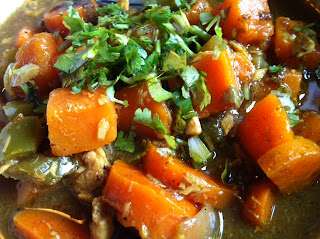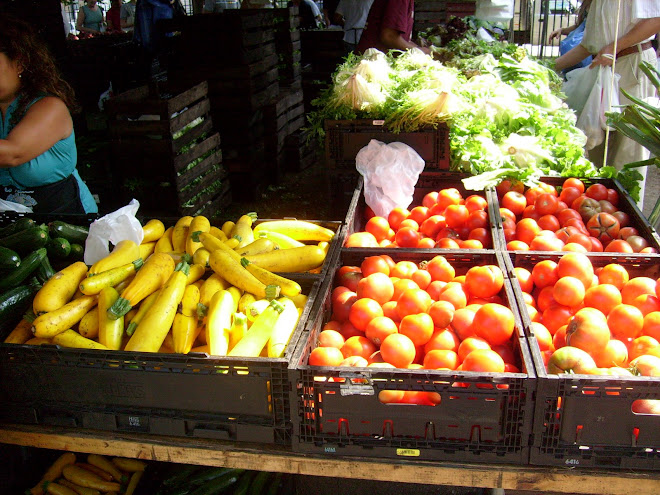Fusion cuisine is something I think about doing often and decide against almost as often, depending on who will be eating the food. Fusing together different cuisines and techniques isn't something everyone loves and definitely requires an open mind and a sense of adventure. For some eaters, it is downright confusing if they are not versed in the inspiration for the new-fangled dish. On the other hand, I love trying favorite ethnic seasonings in unexpected concoctions and some cuisines were just meant to go together, such as French and Moroccan or Peruvian and Chinese. Fusing cuisines and getting super experimental isn't for the beginning cook, but trying it can give a beginner or novice some insight into the creative process used by cooking professionals. Everyone's cooking technique can benefit by pondering what makes nouveau, nouvelle, or fusion foods good.
I love exotic flavors and preparations, but also appreciate classic, reliable American flavors and forms. When I'm thinking of fusing two techniques or cuisines together, sometimes I consider and reconsider, should I use the technique of recipe A and the seasonings of cuisine B or vice versa or somewhere in between? After much trial and error, I usually find that keeping the technique of the title (such as chowder, chili, turnover, wrap, etc) is the best way to ground the dish and keep it true to it's name and your intention. Then comes the switching out of seasonings and ingredients to "fuse" an unexpected flavor, cuisine, or dish into the other. Sometimes you are just dying to use an ingredient scavenged from the greenmarket or you are just trying to use up something in the fridge in a creative way before it goes bad. Either way, developing a complete idea around the ingredient is the best way to ensure that things will come out great without going too far "out there" making the food unrecognizable. Using this theory can keep the novice cook from going completely astray and give the experienced cook or chef a clear sense of direction and, so makes the process more enjoyable. Sounds calculated for such a creative concept, doesn't it? It's not. These are just some general observations and rules of thumb to get thinking about creative cooking technique.
There is lots of room for variation in so-called "fusion cuisine". Here my appreciation for all-American chowder is amped up with my obsession with sweet potatoes and Indian seasonings. Coconut milk replaces milk and cream. Instead of celery and thyme as dominant seasonings, I used chaat masala, whole mustard and cumin seeds, and ginger. Minced cilantro replaces parsley. Finish with a little lemon (or lime!). As this simmered on my stove, I realized it was begging for some seafood (curry, coconut, fish..Yea!) and I had some leftover poached wild salmon hanging around, so in it went! This would be great with protein additions such as fish or shellfish, tofu, red beans, or any other thing you think should be tossed in. My fish was cooked so I added it at the end. For raw fish or meat, add it when you add the sweet potatoes and peppers. The result is technically a chowder, but with pungeant, spicy, and deep flavors of South Indian cuisine. Warm some of this up and enjoy with naan, paratha, rotis, or chapatis and maybe some green chutney and yogurt.
 |
| Gather your mise before you begin! |
Curried Sweet Potato and Coconut Chowder
 |
| 9-grain paratha from my Indian market |
1 t black mustard seeds
1 t whole cumin seeds
1-2 T chaat masala (or substitute garam masala or Sambar)
1 t paprika (I use hot, sweet is okay)
1 t ground turmeric
2 t minced fresh ginger
2 T minced fresh garlic
1 medium onion, diced
2 lb sweet potatoes (Jewel or Garnet yams), peeled and diced
1 green bell pepper, diced
2 lg carrots, sliced into 1/2" rounds
2 t sea salt
1/2-1 t honey (opt.)
2 cans coconut milk (or 1 can coconut milk, 1 can water for a light consistency)
In the bottom of a soup pot, melt down coconut oil and add mustard seeds and cumin seeds. Cook for one minute before adding remaining spices, ginger, and garlic. Stir and cook 3-4 minutes over medium until spices are fragrant.
Add diced onion and cook for another 2-3 minutes, stirring until onion begins to soften. Add sweet potatoes, pepper, and carrots and season with sea salt. Add honey and coconut milk (and water, if using) and stir to incorporate. Turn heat up and bring to almost a boil. Lower heat right away and let simmer for about 25 minutes, uncovered. Stir occasionally and check for tenderness.
When carrots and sweet potatoes are very tender, taste for seasoning and spiciness and adjust. Add about a cup of chopped cilantro and a healthy squirt of lemon juice. Serve immediately or let cool and reheat for later.








1 comment:
excellent musings on the creative process of cooking!
Post a Comment